





In a previous article I introduced the reader to the basics of Agave culitvation and a few of the more common species of Agave. In this one I will touch upon several of the larger species of Agave. This article will in no way be able to cover all the larger Agave species there are, but it should provide at least an introduction to these large desert landscape plants.
In a previous article I introduced the reader to the basics of Agave cultivation and a few of the more common species of Agave. In this one, I will touch upon several more species and add a few ideas about how to take care of these other species. This article will in no way will be able to cover all the larger Agave species there are, nor even all the ones entered in the Davesgarden.com database.
My experience with large agaves began with growing Agave americana, one of the more commonly grown species of agave (at least here in southern California). There are massive plantings of this beautiful but aggressive species all along the highways here. In some California gardens, and throughout Mexico, it is often used as a living fence. And I quickly learned why after planting a few in my old yard. It is a very easy (too easy) species to grow. Next thing I knew was this plant was everywhere, and very hard to eradicate or even to take care of (prune back, etc.). Since then I have tried to be a bit more selective on what species of Agave I let into my yard; still making repeated mistakes, however. Many of the agave species listed below are mildly invasive and some are happily solitary. However, none are nearly as nightmarish as Agave americana varieties are.
Agave americana (aka Century Plant) is a massive plant and is also very variable. There are many varieties of variegated forms in cultivation as well, with some being excellent for smaller gardens or pots, and some being too huge save for a botanical garden or ranch. The normal variety is a dark blue-grey to pale blue-grey-green and has large, sharp teeth and terminal spines. Agave americana 'Variegata' is a longer-leaved plant with curves and twists that look a bit like a plant that is growing underwater, following the currents. The edges of the leaves are yellow with a central green stripe. This plant tends to be far less invasive for some reason. Agave americana mediopicta is the opposite with a central yellow stripe and green margins. Agave americana 'Mediopicta Alba' is similar though it has a white stripe down the middle rather than a yellow one. The mediopicta agaves sucker profusely, but tend to only around the mother plant, not ten feet away or more as the normal blue form does. Agave americana var. striata is a normal-looking form with subtle to marked variegated pale yellow striping. This plant is just as invasive and annoying as the normal blue form. Then there is a variegated form that is monstrose referred to as Agave 'Cornelius'. Most of these are small, stunted plants, many which do not sucker at all, but there are forms (increasingly) in cultivation that do sucker heavily though just around the base of the plant.
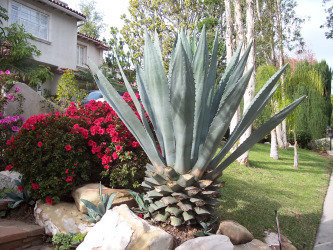
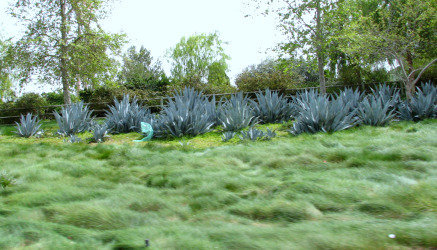
Agave americana in landscaping in a yard in Los Angeles; growing in large numbers along highway in Los Angeles county
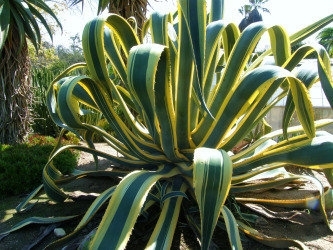
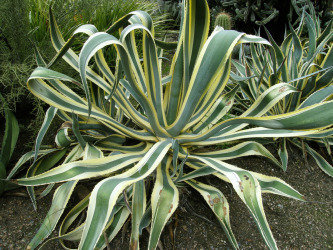
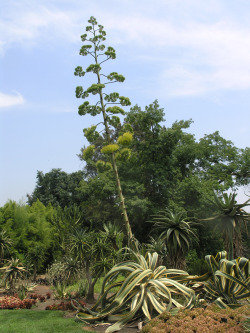 Agave americana variegata photos (flowering on left)
Agave americana variegata photos (flowering on left)
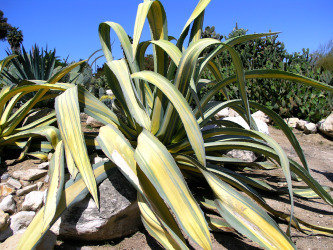
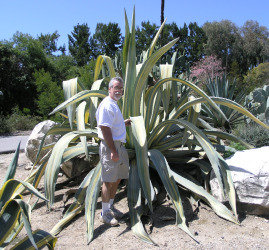
Agave americana striata photos (with author on right)
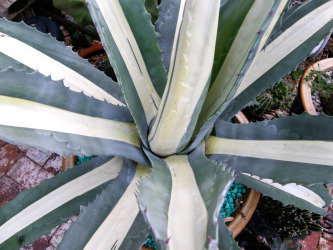
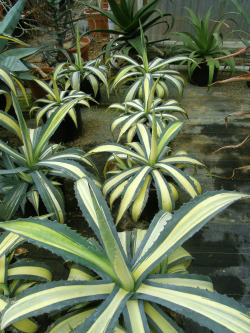
Agave americana mediopicta alba (left) Agave americana mediopicta varieties
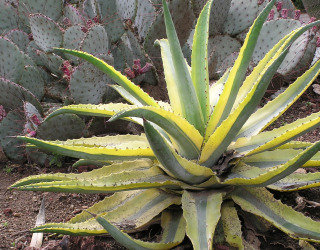 this is Agave americana variegata monstrose (Aka Agave 'Cornelius')
this is Agave americana variegata monstrose (Aka Agave 'Cornelius')
Agave atrovirens (aka Pulque Agave)- this is a wonderfully huge species that is solitary ( no suckers!) and nearly toothless (there are on most leaves some tiny sharp black spines, but very small relative to the size of the massive leaves). Leaf color is turquoise and habit is upright and elegant. There is a huge, stiff terminal spine on each leaf so caution. This is a mid-Mexican species used as a source for Pulque (hence the name), a milky alcoholic beverage. Some tequilas are also made from this plant.
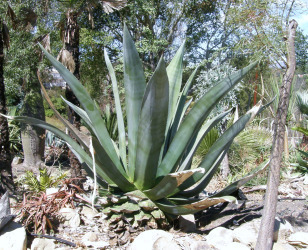
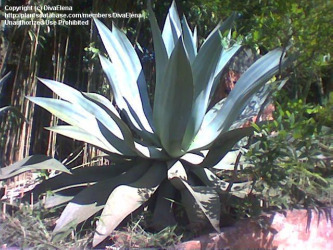
Agave atrovirens in southern California Agave atrovirens (photo DivaElena)
Agave bovicornuta (aka Cow Horn Agave) is one of the more unusual large agaves having bright green leaves. The leaves are flat, ovoid and lined with hooked, black and reddish teeth. Plants are nearly spherical in overall shape and make a wonderful landscape specimen. It is a fast growing plant and tolerates full sun well. This is, as far as I can tell, always a solitary species.
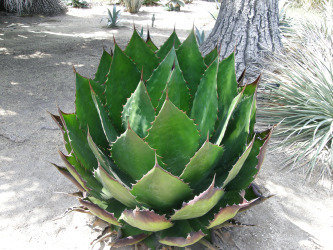
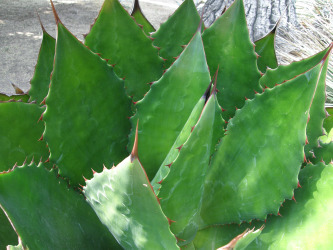
Agave bovicornuta photos
Agave mapisaga- This is another massive Mexican agave also used as a source for Pulque. My only experience with this one is seeing a rare toothless clone of it known as Agave mapisaga var. lisa at the Huntington Gardens. It is probably the largest of the agaves.
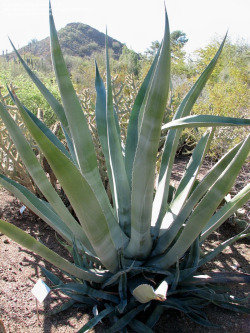
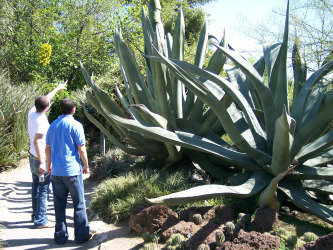
Agave mapisaga (photo equilibrium- left) Agave mapisaga 'Lisa' in Huntington Gardens (right)
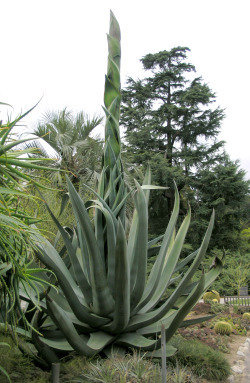
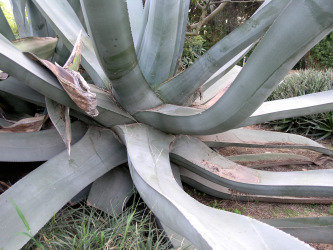
More shots of Agave mapisaga 'Lisa' at the Huntinton Gardens in southern California
Agave franzosinii- some consider this a form of Agave americana, and there are several ‘forms' of this species in cultivation, some which may indeed be some clone of Agave americana. As with many agaves that end up in cultivation, the ones most often propagated are the ones that form suckers as they are they easiest to deal with. Unfortunately suckering forms are sometimes the exception in the wild, not the norm, so the plants one becomes familiar with in cultivation are not necessarily much like the wild forms encountered in nature. This is also unfortunate in that a large non-suckering Agave can be a lot more useful as a landscape plant than one that has to be hacked back repeatedly or weeded out of the rest of one's garden. Agave franzosinii is just such a plant--a beautiful nearly pure white-leaved species with massive, arching leaves making it a fantastic landscaping plant. However, most of the plants I have come across in cultivation are profusely sucking plants that don't match the beauties I see in some of the well known botanical collections in southern California. Some plants sold as Agave franzosinii are a beautiful bright turquoise blue with tiny marginal teeth. These striking plants are great landscaping specimens, but my guess is they are another species or hybrid.
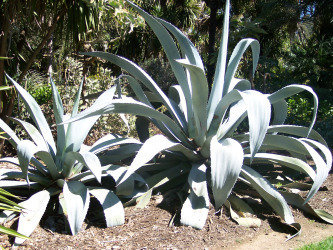
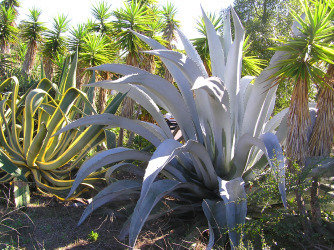
examples of the true Agave franzosinii in southern California
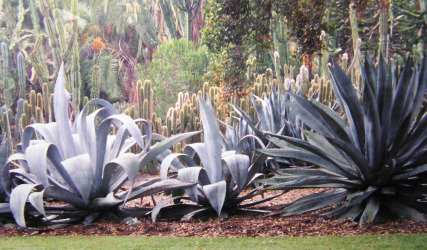 Agave franzosiniis on left and Agave americana on right
Agave franzosiniis on left and Agave americana on right
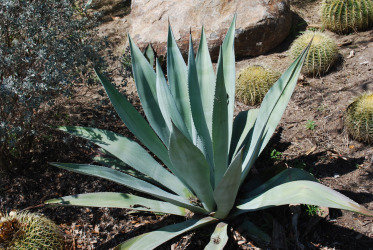
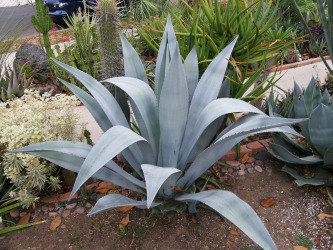
Agave franzosinii 'imposters (left in a botanical garden and right in my own garden- both nice large Agaves, but not the real things?)
Agave guingola is one of my favorite species of agave, though it, too, has been ruined somewhat in cultivation. This is a normally solitary species with pale sea-green, huge, thick leaves with almost insignificant marginal teeth. Most plants sold in nurseries however sucker profusely and tend to have larger teeth. This southern Mexican species is somewhat cold sensitive and does get some minor leaf damage during frosts. But even temps as low as 25F did not kill mine.
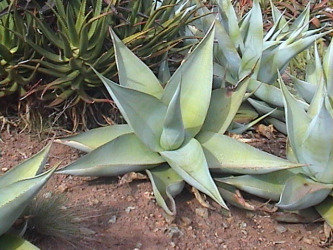
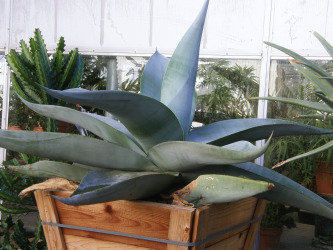
Agave guingolas in the landscape and for sale at a nursery- these are the 'normal' solitary forms
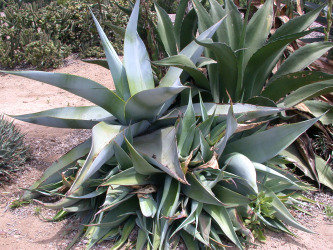 Sadly this suckering 'mess' is usually the forms found in most nurseries
Sadly this suckering 'mess' is usually the forms found in most nurseries
Agave salmiana - this is another common plant in cultivation and one of the few huge agaves with green leaves. This plant is usually distinguished by its wide, deeply fluted leaves. The variety Ferox is a bit smaller and has huge, sometimes curved, marginal teeth, and an exaggerated bend in the leaves to nearly a right angle making the plant urn-shaped. This is another source of Pulque.
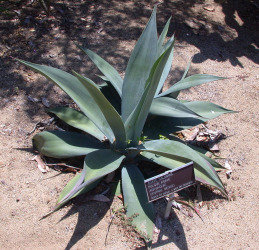
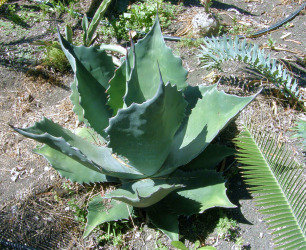
Agave salmiana in botanical garden (left) Agave salmiana var. ferox 'wide leaf' (right)
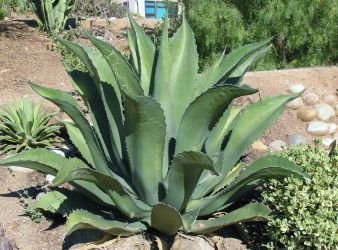
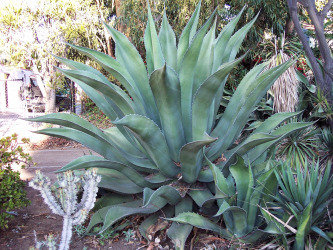
These Agave salmiana var feroxs (aka Agave ferox) are the most common varieties of Agave salmiana seen in cultivation
This is a relatively rare variegated form of Agave salmiana var. ferox 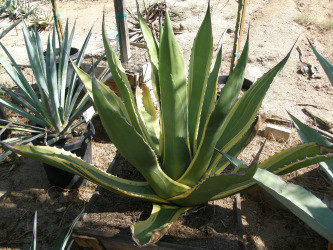
Agave sisalana (aka Sisal) is another large, common species grown primarily for sisal, a fiber used for twine, carpets, yarns, dartboards etc. If one prunes this plant, one will encounter the fibrous nature of the leaves (not terribly unique among agaves). Making a clean cut is not always easy when I trim my plant and often some fibers remain attached to the mother plant making it impossible to pull the leaves away (very tough fibers!). It is a somewhat user-friendly species in that it has no to extremely insignificant teeth along the rubbery stiff leaves making pruning a bit less dangerous than with most other agaves. There is a nasty large terminal spine, however. This is one of the few agaves that forms a real trunk, with plants growing up to about four to five feet of trunk before flowering. This is one of the more cold sensitive species and frosts will sometimes damage the leaves a bit in my yard. It is not nearly as cold sensitive as Agave attenuata, however. No one is sure where this plant originates from and some speculate is a product of cultivation- a hybrid of two other species. Though from Mexico somewhere, Brazil grows the most Agave sisilana now, but it is grown all around the world in many tropical countries. There are several variegated forms of this species, one with stiff leaves and one with floppy ones. The stiff leaved one is a paler color, while the floppier one has deep green striping.
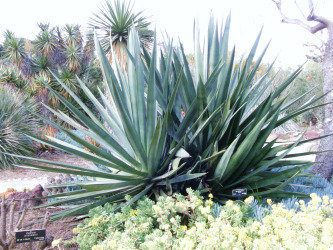
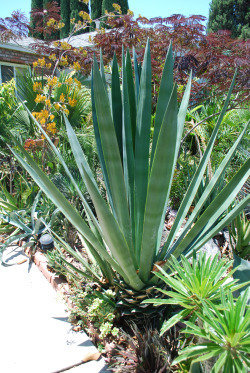
Agave sisalana photos
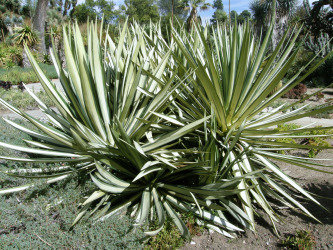
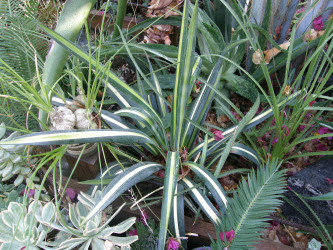
two forms of Agave sisalana variegated -stiff-leaved form on left and a drooping, slower-growing form on right (my garden)
Agave tequiliana (aka Blue Agave)- as the name suggests, this is the primary source for mescal, or tequila. This is a prolific grower and one of the fastest of all the Agaves. I got a small one for one of my planter boxes and in two years it had completely outgrown its spot, not to mention putting out dozens of suckers yearly. Keep that in mind before planting out this species in your garden. This is another variable form that comes in a nice variegated coloration, as well as a pale blue ‘miniature' form (not really small, but smaller than the normal form). This is a dull blue-grey plant, but some develop a really deep blue coloration- these are known as Agave tequiliana 'Weber Blue'. This is a very dangerous plant with straight, stiff leaves, an incredibly sharp terminal spine and tiny but vicsious teeth along the leaf margins that break off easily in one's skin.
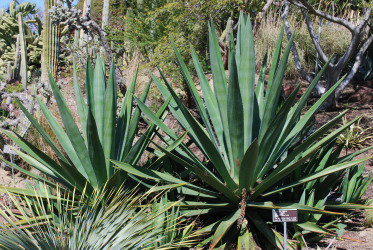
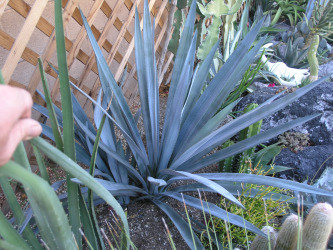
Agave tequilianas (normal on left and Weber Blue on right)
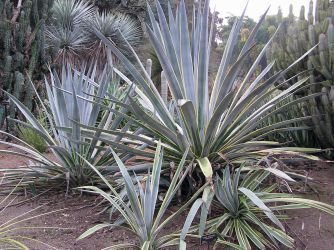
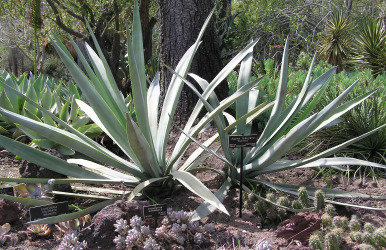
Agave tequiliana 'Sunrise' (variegated)- left Agave tequiliana 'Subtilis'- right
Agave vilmoriniana, or Octupus Agave, is a very commonly grown landscape plant thanks to its nearly harmless leaves and rapid growth to landscape size. The leaves are rubbery and arching without any marginal teeth and a relatively soft, terminal spine. This one is a short-lived species, however, growing from a seedling to flowering adult in just 5 to 7 years. But it produces thousands of bulbils (baby plantlets) on the flower stalk so propagation is not a problem.
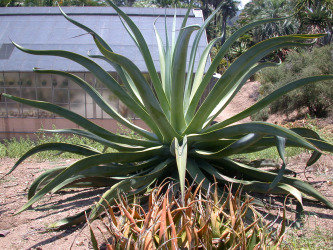
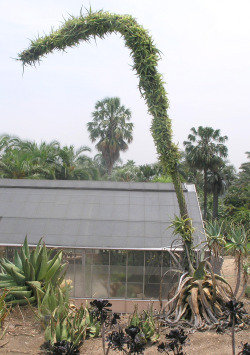
Agave vilmoriniana dying plant after flowering covered with bulbils
Agave weberi is another fairly large agave growing up to five feet tall and a foot or more wider than that. It looks initially like an Agave americana only it is somewhat greener (pale grey green in color) and has none to very tiny marginal teeth, making it one of the less dangerous of the large agaves. However it still has nasty terminal spine. There are beautiful variegated forms of this available in cultivation.
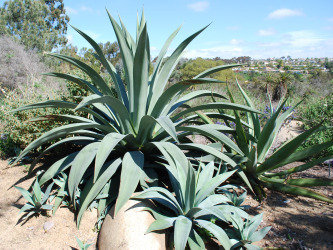
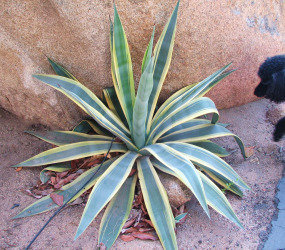
Agave weberis variegated Agave weberi
There are dozens of other huge agave species (see more examples below), but this will at least introduce the reader to some of the more common ones encountered in cultivation.
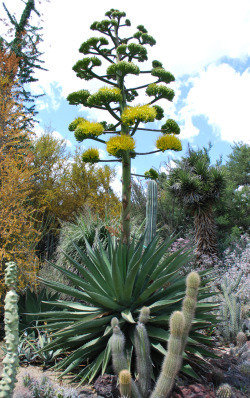
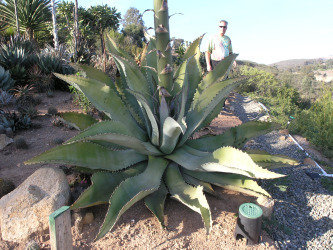
Agave avellanidens in flower (left) Agave marmorata (right)
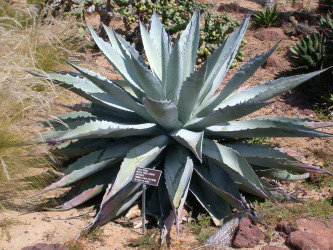
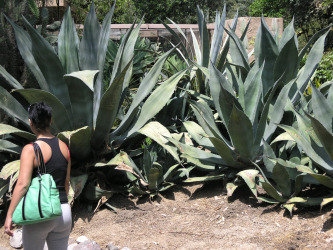
Agave sobria (left) Agave tectas (right)
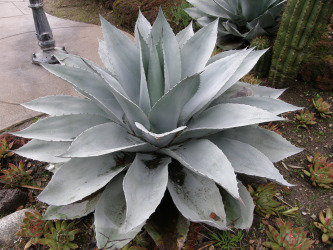
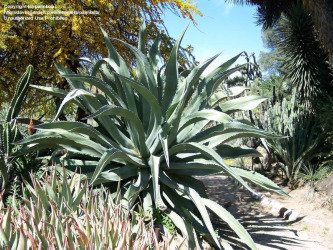
Agave ovatifolia (left) Agave ragusae (right)
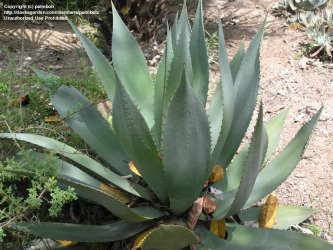
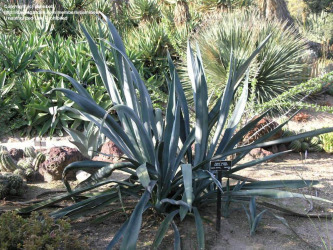
Agave albescens (left) Agave cantala (right)
Copyright © www.100flowers.win Botanic Garden All Rights Reserved